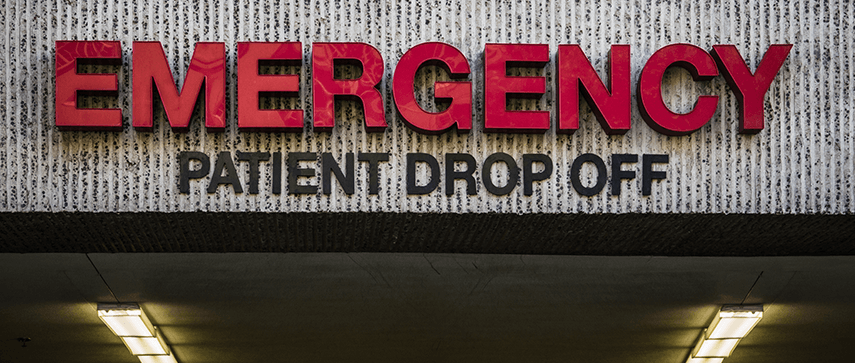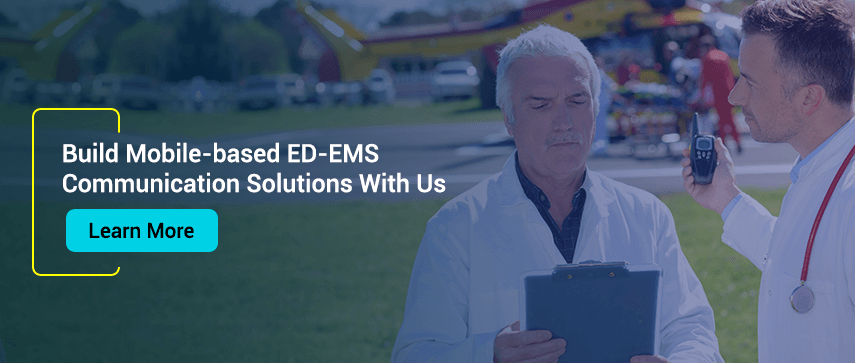A 45-year-old man is at his workplace. Suddenly he feels a sharp pain in his chest and collapses. The peers immediately call for an ambulance service and try to give first aid to the man. The patient is being taken to the nearest hospital. Meanwhile, the emergency medical services (EMS) unit collects patient’s information from the peers, own examinations, and make reports. Upon reaching the emergency department (ED) of the hospital, they hand over the patient’s reports to the ED nurses. The nurse communicates this information to the ED doctor. But there are some key parameters missing on the report.
The doctor fails to figure out the exact scenario of the ischemic stroke because the reports aren’t standardized. She calls the EMS agency and tries to get more information about the patient’s condition.
Due to the lack of appropriate information, she decides to go ahead with her own physical examination of the patient. The whole process consumes a lot more time than what should be relevant in an acute healthcare situation, and this could be potentially hazardous for the patient on the bed.
At a healthcare unit with all the appropriate devices, technology for treatments, best healthcare professionals, time is probably the only thing that the patient does not have.
The interruptions caused during an emergency situation can lead to a negative impact on the patient's health. A study reports that on an average 30.1% of a physician's conversations are interrupted.
Though it might sound surprising, a lot of EMS providers find handoff extremely frustrating due to certain barriers. The whole disorganized structure of most hospitals’ systems, lack of time and focus, coupled with lack of respect for the EMS providers is definitely not a good way to keep the Emergency Medical Service providers motivated.
A qualitative study of 90 EMS handoffs proved that EMS providers tend to miss out many important details while reporting the patient to the ED during the handoff.
This calls for a means of better communication between EMS agencies, ED, and people of ED, and thus high-quality handoffs.
What Is ED-EMS Communication?
The EMS communication system can be defined as a system which helps synchronize critical medical care in emergency settings such as hospital emergency departments, ambulances, and dispatch centers. The system aims to care for serious patients to lessen potential harm to their health.
There’s a Need for Better ED-EMS Communication
A study by JAMA researchers suggests that the arrival of an emergency medical service unit can take from 7 minutes to 28 minutes at the scene and almost 1 in every 10 patients face 30 minutes or longer wait. That median time gets larger to more than 14 minutes in rural backdrops. With the criticality of that moment and the lack of time, anything that can shave off some time to get the patient to the ED is more than welcome to carry out the handoff. However, it is important to understand what exactly is involved in the EMS-ED handoff.
- When the patient moves from the emergency medical service providers to the ED, their health reports, their first aid procedure, their examination (by the EMS) reports, are also handed off to the ED reception.
- The ED reception then makes calls and relays the details of the patient further to the doctors and specialists.
- The specialists are then required to add to the information (if necessary) and sent out to the respective laboratories, as per the requirement.
So, here are the problems with the current state of the system:
- As per the current structure of most hospitals, the data transfer happens through radio, phone calls or non-standardised pages of text. The lack of standardization in this data transfer between agencies (same or different) requires a lot of time to interpret, consequently, it can be critical for the patient, especially in acute situations.
- Having said that, it is also crucial to accept the fact that a patient in an emergency case has to pass through different healthcare providing units across the same or different organizations. Just to name a few of these entities: Government-owned, Charity-based, Private-owned, Combined, Hospital provided, EMS and ED, and their different combinations. Most importantly, it moves across people; and it is very easy for communication to break if the health data exchange process is not seamless.
According to studies, efficiency in the communication system and correct data transfer can reduce medical errors by almost 30% and can shave off nearly 28-46% of the operating time.
How Mobile Technology Makes EMS Communication Significantly Better?

Transferring and analyzing data has never been easier than what it is today. Major companies in the market like Ola, Uber, Lyft, are all mobile app-based. They use mobile technology to connect people with taxis, without owning a single taxi of their own. Communication and data exchange can be made that simple too if one knows how to use leverage smartphones and internet connectivity.
Custom mobile apps that are easily accessible by the emergency medical service personnel and the ED staff can provide a much smarter means of communication between them to streamline the health data exchange. Here’s how -
EMS - send information in advance, ED - prepare for patient’s arrival in advance
Having to update a patient’s information over and over again over a cell phone or over messages or in person, can be unbelievably cumbersome. Replacing this with an app that can take pictures, patient information, can be a boon. The app would alert the ED specialists while the patient is traveling. This can reduce the amount of time that would have otherwise been consumed after the patient reached the hospital door. And standardizing the information passed on, to alert the Emergency Department also makes it easier and more efficient for the ED specialists/doctors to understand the patient's condition in advance.
Bridge communication gaps
Even today, with so much advancement in technology, it would be surprising to know that at most hospitals, after the patient is brought to the hospital door, a nurse relays all the information passed onto her from the EMS providers to the ED specialists over phones or radio channels. Imagine the scope of miscommunication that underlies this process.
Pressing a button to relay the same and standardized information to any entity of the hospital (as and when required) can avoid miscommunication massively. To have the liberty to attach further documents as the process moves on, would allow seamless transfer and thorough health report of patients, along with a reduction in time.
Improve transparency
Having a centralized server where data from all remote agencies, entities are stored of the patient ensures that the health record is transparent and accurate, as compared to verbatim communications via radios. These mobile applications can also record and store the patient’s check-in time, the patient’s in-time condition, location to ensure there is almost no scope of fraudulence and mistakes.
Quicker reimbursements and insurance claims
With all the data centrally stored in a server, it becomes much more efficient and easier to share thorough health reports, bills, patient’s conditions, all at the press of a button, with the insurance agencies. Thus making it easier for reimbursement and claim processes. Also, the standardization of these bills and reports will make it quicker for the insurance agencies to glance through and release payments.
Are Hospitals Already Using These Apps to Work Efficiently With EMS?
Apps like Pulsara, Twiage, ESO health data exchange are being used at various hospitals. One such example is Hayward Memorial Hospital that is using Twiage for the efficiency of their work process.
The usage of the app has made the hospital ED team better prepared at the time of emergencies before the patient arrives. It has ensured transparent and thorough health data exchange within the organization and beyond. It has also made it easier to keep the data confidential.
Concluding Remarks: The future of EMS communication is mobile
Although it is not uncommon to see humans being resistant to any sort of change at first, the advantages of mobile technology when it comes to increasing survival rate by shaving off time and efficiently transferring data cannot be denied. All the hospitals that have used this technology have found it incredibly helpful, and haven’t looked back since.
In the future, there is a huge scope of making use of existing sensors and microchips on smartphones to collect data remotely without having to use a lot of equipment. Setting up the equipment and machines also take time and that can be shaved off by using the omnipresent mobile devices at least for the basic tasks.
It is high time EMS providers and hospital EDs change their age-old, redundant systems, and bring in mobile technology to make health data exchange more efficient, and consequently improve the survival rate of their patients.





 April 1, 2019
April 1, 2019


